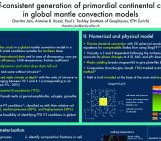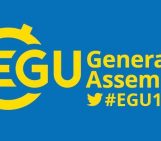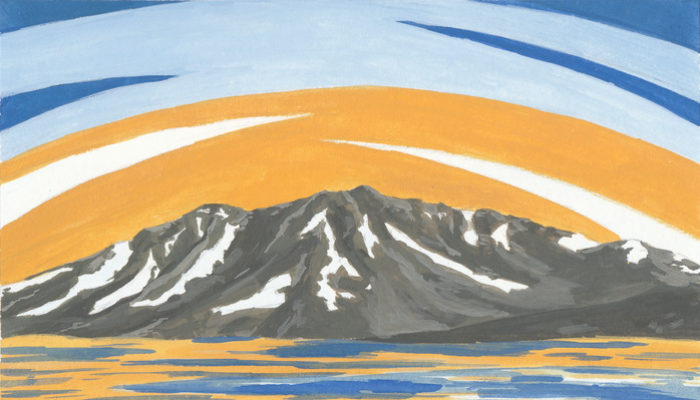
Have you ever wondered to learn more about the geological setting of the Nevado volcano in Central-West Argentina? In this week’s blog, we have Georgina Rubiano Lorenzoni, a Ph.D. Geologist student from the Universidad Nacional de La Pampa in Argentina, who will guide us through her thesis aims, which are the identification and investigation of the petrogenesis and geochronology of the mountain range Sierra del Nevado in East Mendoza, Argentina.
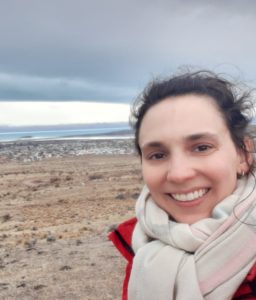
Georgina Rubiano Lorenzoni is a Ph.D. Geologist student at the Universidad Nacional de La Pampa in Argentina, in the department of Earth Sciences. She has demonstrated an excellent working experience in the Petrology and Geochemistry research areas. You can contact her via e-mail, LinkedIn, or Twitter (@GeorginaRubiano).
The proposed study area for my Ph.D. thesis is the region of Sierra del Nevado, which is situated in the extra-back arc of the Andean Southern Volcanic Zone (SVZ). This particular area belongs to Payenia volcanic province (Fig. 1; 34–38°S, Mendoza, Argentina), and includes the Nevado stratovolcano and several minor polygenetic volcanoes (e.g. Plateado, Pelado, and Los Cerritos). In fact, there were found igneous Nevado rocks that have some petrological arc-like signatures but they are 200 km away from the Andean arc front.
Standing tall among the dunes and lakes around this mystical area lies the mountain range of Sierra del Nevado in the eastern part of Mendoza. This part has been integrated by a stratovolcano called Cerro Nevado, which is surrounded by several minor polygenetic volcanoes (e.g. Plateado, Pelado, and Los Cerritos), as well as basaltic monogenetic cones that belong to a greater collection of volcanoes, known as the Payenia Volcanic Province (PVP, 34–38°S, Mendoza, Argentina). Despite being a stratovolcano with an arc-like signature, which would normally mean that Sierra del Nevado would have been in the front arc, it is instead found in the extra-back arc of the Andean Southern Volcanic Zone (SVZ) at 200 km away from the Andean arc front.
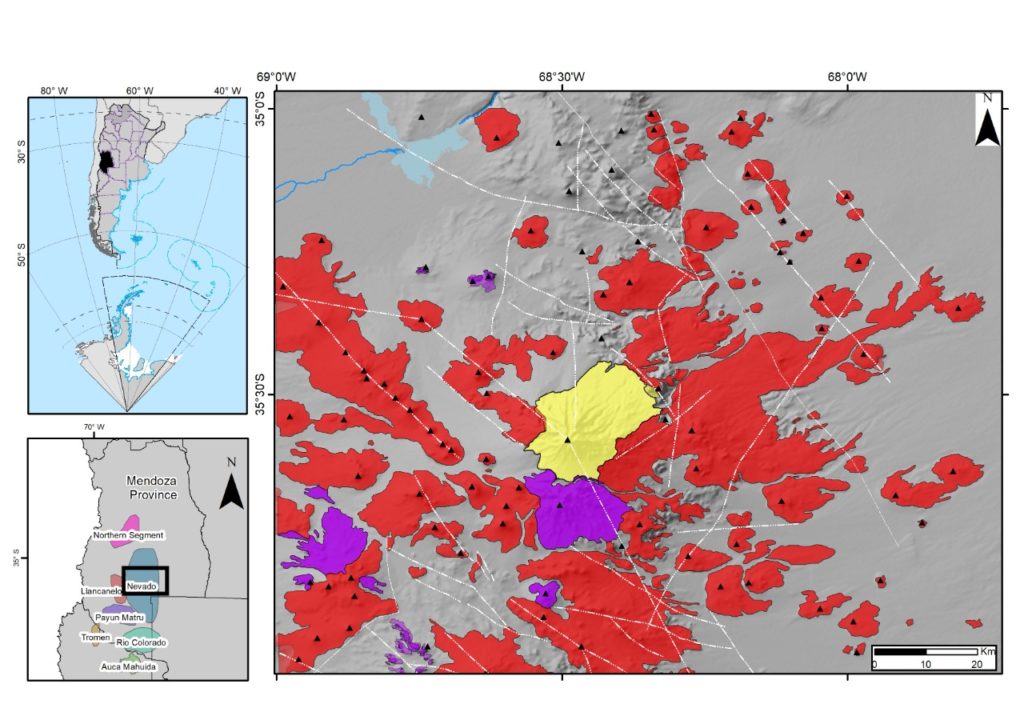
Figure 1: This compilation of maps represents (top left) the political Argentinian map and Mendoza province, which is highlighted as the study area. The Payenia volcanic fields (bottom left) were taken from Gudnason et al. 2012 and Søager et al. 2013. The right map depicts the Sierra del Nevado volcanic units, which are Cortaderas Fm (Violet colour), Nevado Fm (Yellow colour), Chapúa Group (Red colour) and the black triangles are the volcanic cones, and all were taken from Sepúlveda et al. 2007.
The Payenia Volcanic Province (PVP) is a back-arc association between 33º40´S and 38º00’S, where basaltic monogenetic cones, small polygenetic cones, and some big eruptive centers take part in this province (Llambías et al. 2010). Gudnason et. al. 2012 and Søager et al. 2013 divided the PVP into sub-fields based on geochronological and isotopic data: a) The Nevado volcanic field, which belongs to our study area, with ages between 2.8 and 0.7 Ma. b) The Llancanelo volcanic field, with ages between 400 and 60 ka. c) The Northern segment including the Cerro Diamante with ages between 700 and 50 ka. d) The Payún Matrú volcanic field with ages between 400 ka to recent. e) The Río Colorado volcanic field with ages from 2.1 to 0.34 Ma.f) The Auca Mahuida volcanic field with Pleistocene ages, from 1,7 to 0,88 Ma, and g) The Tromen volcanic field with ages from 2.3 Ma until recent.
Testing hypotheses about the origin of the Payenia Volcanic Province (PVP)
There is an ongoing debate about the exact origin of the Payenia Volcanic Province (PVP). The following scenarios could possibly have generated the creation of the PVP: a) melting of the hydrated mantle after a temporary low-angle subduction episode in the late Miocene (Kay and Mancilla, 2001; Kay et al., 2013); b) a decapitated upper mantle plume-like (Burd et al., 2014). d) an upwelling of EM1-type material from the deeper mantle (Søager et al., 2015). e) Slab break-off and assimilation by the Payenia plume (Gianni et al. 2017), and f) melting of the metasomatised subcontinental lithospheric mantle (Chilson-Parks et al. 2022).
Furthermore, the rocks of the Sierra del Nevado area can be grouped into three volcanic episodes (Sepúlveda et al. 2007):
1) Cortaderas Formation (upper Miocene) includes the andesitic, dacitic, and rhyolitic rocks that form the minor volcanic edifices.
2) Nevado Formation (Lower Pliocene) with basalts, trachyandesites, trachytes, and dacites from the Nevado volcano edifice.
3) Chapúa Group (Upper Pliocene-Lower Pleistocene) including basaltic rocks (pyroclastics and lava flows).
In this project, the main goal is to find answers regarding the petrology and geochemistry of the Nevado volcanic area. To be more precise, it is of great importance to discover:
- Why is a stratovolcano located (Cerro Nevado) 200 km away from the arc front, and what are the magma generation mechanisms?
- How long did the polygenetic volcanic activity last, and what caused the transformation from polygenetic to monogenetic volcanoes mainly composed of basaltic rock?
For carrying through this project, five field trips were made for sampling acquisition. The collected samples were from three volcanic units considering the different volcanic phases. All the necessary rock analyses and K-Ar ages were carried out at the University of Tokyo (U-Tokyo), and Sm-Nd isotopic determination and major-element compositions of the minerals were implemented at the Universidade de Brasília (UnB). Lastly, trace element mineral chemistry was conducted at Università Degli Studi di Modena e Reggio Emilia.
Some Preliminary Results
Ages
As previous works have reported, Cortaderas Fm. is the oldest unit from Sierra del Nevado with ages between 11.73 and 3.53 Ma followed by Nevado Fm. 1.67 to 1.079 and at the same time Chapúa Gp. with ages ranging from 1.84 to 0.78 Ma.
Major Elements
The three lithological units were classified with the Total Alkali-Silica diagram (TAS). The Cortaderas have a variable composition that includes basaltic andesites, andesites, dacites, and trachytes all of them are subalkaline and calcoalcaline. The Nevado Fm. is composed of basalts, trachybasaltic andesites, trachyandesites, trachytes, and dacites mostly alkaline followed by subalkaline (calc-alkaline). The Chapúa Gp. is consisted mainly of basalts and to a lesser extent of trachybasalts.
Trace Elements
Regarding the trace elements, all samples showed volcanic arc patterns with negative anomalies of Nb-Ta and Ti, and positive anomalies of Pb and Sr. The Cortaderas rocks are enriched in Sr (>500 ppm), and few of them have been strictly plotted on the adakite field in the Sr/Y vs. Y and La/Yb vs. Yb diagrams (e.g., Defant and Drummond 1990, Castillo 2012). This could be a consequence of a) Melting of the Lower Crust (e.g. Wang et al. 2004), b) fractional crystallisation of hydrous mafic magmas (e.g. Castillo 2012) or c) high-pressure fractional crystallisation of arc mafic magmas (e.g. Macpherson et al. 2006).
Despite my keen interest in this topic, the project was initially started a long time ago. Back in 2007, Dr. Yuji Orihashi was responsible for this initiative along with a scientific group of Japanese, Brazilian and Argentinian researchers. Due to the lack of researchers interested in taking up the project as their Ph.D. thesis, the project was put on ice until 2016. It was that same year that I applied for a Ph.D. grant for CONICET (National Scientific and Technical Research Council) with this topic as my proposal, and fortunately, everything worked well, and I was granted the scholarship at the beginning of 2017.
As for myself, working on the Sierra del Nevado project has been a great challenge, not only from an academic perspective but also from a personal one. This project allowed me to carry out multiple types of analyses in a wide range of institutions in other countries, and meet researchers and Ph.D. students from different cultures and backgrounds, which made me get out of my comfort zone as a young scientist. However, one of the most difficult parts of my Ph.D. was applying all the theories that I learned throughout my studies to practice whilst doing the lab work. This experience truly shaped me as a young Geologist in research and enabled me to explore different patterns through a prism that I had never imagined. On a further note, I would like to express my gratitude to all the local people of the aforementioned institutions because without their valuable help I would not have participated in the training and internships abroad. Last but not least, I would also like to thank all the Sierra del Nevado residents, who have helped the research team numerous times over the years, including myself back when I was there in 2017. Because at the end of the day, what matters the most to me is that research work should be treated with mutual respect of the people as it is of the place itself.
References Burd, A. I., Booker, J. R., Mackie, R., Favetto, A., Pomposiello, M. C. 2014. Three-dimensional electrical conductivity in the mantle beneath the Payún Matrú Volcanic Field in the Andean backarc of Argentina near 36°5’S: evidence for de- capitation of a mantle plume by resurgent upper mantle shear during slab steepening. Geophysical Journal International. 198, 812–827. Castillo, P. R. 2012. Adakite petrogenesis. Lithos, 134, 304-316. Chilson‐Parks, B. H., Calabozo, F. M., Saal, A. E., Wang, Z., Mallick, S., Petrinovic, I. A. Frey, F. A. 2022. The signature of metasomatized subcontinental lithospheric mantle in the basaltic magmatism of the Payenia volcanic province, Argentina. Geochemistry, Geophysics, Geosystems, 23(1), e2021GC010071. Defant, M. J., Drummond, M. S. 1990. Derivation of some modern arc magmas by melting of young subducted lithosphere. Nature, 347(6294), 662–665. Gianni, G. M., García, H. P., Lupari, M., Pesce, A., Folguera, A. 2017. Plume overriding triggers shallow subduction and orogeny in the southern Central Andes. Gondwana Research, 49, 387-395. Gudnason, J., Holm, P. M., Søager, N., Llambías, E. J. 2012. Geochronology of the late Pliocene to recent volcanic activity in the Payenia back-arc volcanic province, Mendoza Argentina. Journal of South American Earth Sciences, 37, 191-201. Kay, S., Mancilla, O. 2001. Neogene shallow subduction segments in the Chilean/Argentine Andes and Andean-type margins. GSA Annual Meeting S. 63. Modern and Ancient Plate Boundaries and Orogens I. Kay, S.M., Jones, H.A., Kay, R.W., 2013. Origin of Tertiary to Recent EM- and subduction-like chemical and isotopic signatures in Auca Mahuida region (37–38°) and other Patagonian plateau lavas. Contributions to Mineralogy and Petrology 166 (1), 165–192. Llambías, E. J., Bertotto, G. W., Risso, C., Hernando, I. 2010. El volcanismo cuaternario en el retroarco de Payenia: una revisión. Revista de la asociación Geológica Argentina, 67(2), 278-300. Macpherson, C. G., Dreher, S. T., Thirlwall, M. F. 2006. Adakites without slab melting: high-pressure differentiation of island arc magma, Mindanao, the Philippines. Earth and Planetary Science Letters, 243(3-4), 581-593. Søager, N., Holm, P. M., Thirlwall, M. F. 2015. Sr, Nd, Pb, and Hf isotopic constraints on mantle sources and crustal contaminants in the Payenia volcanic province, Argentina. Lithos, 212, 368-378. Wang, Q., Hao, L., Zhang, X., Zhou, J., Wang, J., Li, Q., Y., Tang G., Dan W., Fan, J. 2020. Adakitic rocks at convergent plate boundaries: Compositions and petrogenesis. Science China Earth Sciences, 63(12), 1992-2016.



